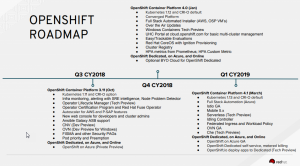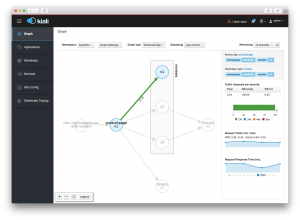OpenShift 2019 Roadmap – What’s Cool?
OpenShift 3.11 release
In late 2018, Red Hat released OpenShift 3.11. Major features we cared about were:
- CRI-O – a replacement container service (over Docker, although it can still run Docker containers) that isn’t controlled by a single company (6 Reasons why CRI-O is the best runtime for Kubernetes)
- Improved infrastructure alerting and monitoring
- New web console for admins
There are some great words here about what else was part of 3.11.
For what it’s worth, upgrades don’t have to be super painful. At our last company, we updated very smoothly from 3.6 to 3.10 via a parallel upgrade and resource copy (via some super sweet automation,  , nerd alert…) and then did an immediate upgrade in place to 3.11.
, nerd alert…) and then did an immediate upgrade in place to 3.11.
What Are We Excited about in OpenShift 4.0?

Highlights
Red Hat is switching over to CoreOS as the host OS, and that will enable a lot of nice features like over the air updates and infrastructure alerting. Operations will find this to be a lot easier.
Major updates are coming for the internal registry. Red Hat is planning on swapping out the existing internal registry technology for Quay, the registry technology they acquired from Tectonic/CoreOS (actually many of the new features in the 4.x series of releases look to be rolling in features from the Tectonic/CoreOS purchase).
Quay’s major features include geo replication and integrated container security scanning with Clair. Red Hat plans to produce one version of Quay (to include with OpenShift) that matches the features in the existing OpenShift registry. They’ll also produce another version of Quay that has all of the bells and whistles that Quay provides now.
More Exciting Stuff in 4.1!
Istio! 

Understanding Istio is a whole series of blog posts (or even a book) on its own, but the short version is that it’s an excellent service mesh – which can both monitor and control all network traffic in a cluster.
It’s been in Tech Preview for a few releases, and it’s planned to go live in version 4.1.
Serverless: Knative?
The OpenShift Roadmap mentions “Serverless” in Tech Preview.
According to the CNCF,
Serverless computing refers to the concept of building and running applications that do not require server management. It describes a finer-grained deployment model where applications, bundled as one or more functions, are uploaded to a platform and then executed, scaled, and billed in response to the exact demand needed at the moment.”
TLDR: if containers are a simpler way to deploy and run applications than VMs, serverless applications are an even simpler way to run applications than containers. You don’t have to worry about middleware at all, you just write some code and deploy it.
There are several serverless options out there, and the original OpenShift discussions were around OpenWhisk, but the OpenShift blog has several posts. Here are a couple good ones explaining more about it:
Our best guess is that Knative will be the flavor of serverless technology that goes into Tech Preview in 4.1. This is good, because it’s the most open and widely supported serverless technology.
Eclipse Che: Cloud-based IDE
Eclipse Che is a browser-based IDE. We’re interested in it because it means that a developer can do all of their usual programmer tasks with zero desktop application install. Just click a link, wait for Che to load, and be off and running. Compared to setting up a desktop-based Eclipse IDE and getting servers running locally, this could be another huge improvement in developer efficiency with OpenShift and containers.
Originally Che was planned for OpenShift 4.x, but it was recently branded as Code Ready Workspaces and released – we aren’t entirely sure why it’s on the Roadmap still, but hey, good news! You don’t have to wait for 4.x to use it.
The Future
OpenShift’s future has a lot of cool stuff in it – and we don’t even know the road map beyond mid 2019. Chances are good that a lot more cool stuff will be announced at Summit, in May.
Also, if creepy-stalking being good at finding stuff on the internet is your jam, you can also keep an eye on the OpenShift Trello boards.
